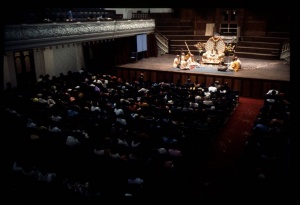CC Adi 10.106 (1975): Difference between revisions
(Vanibot #0027: CCMirror - Mirror CC's 1996 edition to form a basis for 1975) |
(Vanibot #0020: VersionCompareLinker - added a link to the Version Compare feature) |
||
| Line 2: | Line 2: | ||
<div style="float:left">'''[[Sri Caitanya-caritamrta (1975)|Śrī Caitanya-caritāmṛta (1975)]] - [[CC Adi (1975)|Ādi-līlā]] - [[CC Adi 10 (1975)|Chapter 10: The Trunk, Branches and Subbranches of the Caitanya Tree]]'''</div> | <div style="float:left">'''[[Sri Caitanya-caritamrta (1975)|Śrī Caitanya-caritāmṛta (1975)]] - [[CC Adi (1975)|Ādi-līlā]] - [[CC Adi 10 (1975)|Chapter 10: The Trunk, Branches and Subbranches of the Caitanya Tree]]'''</div> | ||
<div style="float:right">[[File:Go-previous.png|link=CC Adi 10.105 (1975)|Ādi-līlā 10.105]] '''[[CC Adi 10.105 (1975)|Ādi-līlā 10.105]] - [[CC Adi 10.107 (1975)|Ādi-līlā 10.107]]''' [[File:Go-next.png|link=CC Adi 10.107 (1975)|Ādi-līlā 10.107]]</div> | <div style="float:right">[[File:Go-previous.png|link=CC Adi 10.105 (1975)|Ādi-līlā 10.105]] '''[[CC Adi 10.105 (1975)|Ādi-līlā 10.105]] - [[CC Adi 10.107 (1975)|Ādi-līlā 10.107]]''' [[File:Go-next.png|link=CC Adi 10.107 (1975)|Ādi-līlā 10.107]]</div> | ||
{{CompareVersions|CC|Adi 10.106|CC 1975|CC 1996}} | |||
{{RandomImage}} | {{RandomImage}} | ||
==== TEXT 106 ==== | ==== TEXT 106 ==== | ||
<div class="verse"> | <div class="verse"> | ||
: | :śaṅkarāraṇya--ācārya-vṛkṣera eka śākhā | ||
:mukunda, kāśīnātha, | :mukunda, kāśīnātha, rudra--upaśākhā lekhā | ||
</div> | </div> | ||
| Line 18: | Line 17: | ||
<div class="synonyms"> | <div class="synonyms"> | ||
śaṅkarāraṇya—of the name Śaṅkarāraṇya; ācārya-vṛkṣera—of the tree of ācāryas; eka—one; śākhā—branch; mukunda—of the name Mukunda; kāśīnātha—of the name Kāśīnātha; rudra—of the name Rudra; upaśākhā lekhā—they are known as subbranches. | |||
</div> | </div> | ||
| Line 25: | Line 24: | ||
<div class="translation"> | <div class="translation"> | ||
The ācārya Śaṅkarāraṇya was considered the forty-eighth branch of the original tree. From | The ācārya Śaṅkarāraṇya was considered the forty-eighth branch of the original tree. From him proceeded the subbranches known as Mukunda, Kāśīnātha and Rudra. | ||
</div> | </div> | ||
| Line 32: | Line 31: | ||
<div class="purport"> | <div class="purport"> | ||
It is said that Śaṅkarāraṇya was the sannyāsa name of Śrīla Viśvarūpa, who was the elder brother of Viśvambhara (the original name of Śrī Caitanya Mahāprabhu). Śaṅkarāraṇya expired in 1432 | It is said that Śaṅkarāraṇya was the sannyāsa name of Śrīla Viśvarūpa, who was the elder brother of Viśvambhara (the original name of Śrī Caitanya Mahāprabhu). Śaṅkarāraṇya expired in 1432 śakābda (A.D. 1512) at Sholapur, where there is a place of pilgrimage known as Pāṇḍerapura. This is referred to in the Madhya-līlā, Chapter Nine, verses 299 and 300. | ||
Lord Caitanya Mahāprabhu opened a primary school in the house of Mukunda, or Mukunda Sañjaya, and Mukunda's son, whose name was Puruṣottama, became the Lord's student. Kāśīnātha arranged the marriage of Lord Caitanya in His previous āśrama, when His name was Viśvambhara. Kāśīnātha induced the court paṇḍita, Sanātana, to offer Viśvambhara his daughter. In the Gaura-gaṇoddeśa-dīpikā, verse 50, it is mentioned that Kāśīnātha was an incarnation of the brāhmaṇa Kulaka, whom Satrājit sent to arrange the marriage of Kṛṣṇa and Satyabhāmā, and it is mentioned in verse 135 that Rudra, or Śrī Rudrarāma Paṇḍita, was formerly a friend of Lord Kṛṣṇa's named Varūthapa. Śrī Rudrarāma Paṇḍita constructed a big temple at Vallabhapura, which is one mile north of Māheśa, for the Deities named Rādhāvallabha. The descendants of his brother, Yadunandana Vandyopādhyāya, are known as Cakravartī Ṭhākuras, and they are in charge of the maintenance of this temple as sevaits. Formerly the Jagannātha Deity used to come to the temple of Rādhāvallabha from Māheśa during the Ratha-yātrā festival, but in the Bengali year 1262 (A.D. 1855), due to a misunderstanding between the priests of the two temples, the Jagannātha Deity stopped coming. | |||
</div> | </div> | ||
Latest revision as of 14:03, 26 January 2020

A.C. Bhaktivedanta Swami Prabhupada
TEXT 106
- śaṅkarāraṇya--ācārya-vṛkṣera eka śākhā
- mukunda, kāśīnātha, rudra--upaśākhā lekhā
SYNONYMS
śaṅkarāraṇya—of the name Śaṅkarāraṇya; ācārya-vṛkṣera—of the tree of ācāryas; eka—one; śākhā—branch; mukunda—of the name Mukunda; kāśīnātha—of the name Kāśīnātha; rudra—of the name Rudra; upaśākhā lekhā—they are known as subbranches.
TRANSLATION
The ācārya Śaṅkarāraṇya was considered the forty-eighth branch of the original tree. From him proceeded the subbranches known as Mukunda, Kāśīnātha and Rudra.
PURPORT
It is said that Śaṅkarāraṇya was the sannyāsa name of Śrīla Viśvarūpa, who was the elder brother of Viśvambhara (the original name of Śrī Caitanya Mahāprabhu). Śaṅkarāraṇya expired in 1432 śakābda (A.D. 1512) at Sholapur, where there is a place of pilgrimage known as Pāṇḍerapura. This is referred to in the Madhya-līlā, Chapter Nine, verses 299 and 300.
Lord Caitanya Mahāprabhu opened a primary school in the house of Mukunda, or Mukunda Sañjaya, and Mukunda's son, whose name was Puruṣottama, became the Lord's student. Kāśīnātha arranged the marriage of Lord Caitanya in His previous āśrama, when His name was Viśvambhara. Kāśīnātha induced the court paṇḍita, Sanātana, to offer Viśvambhara his daughter. In the Gaura-gaṇoddeśa-dīpikā, verse 50, it is mentioned that Kāśīnātha was an incarnation of the brāhmaṇa Kulaka, whom Satrājit sent to arrange the marriage of Kṛṣṇa and Satyabhāmā, and it is mentioned in verse 135 that Rudra, or Śrī Rudrarāma Paṇḍita, was formerly a friend of Lord Kṛṣṇa's named Varūthapa. Śrī Rudrarāma Paṇḍita constructed a big temple at Vallabhapura, which is one mile north of Māheśa, for the Deities named Rādhāvallabha. The descendants of his brother, Yadunandana Vandyopādhyāya, are known as Cakravartī Ṭhākuras, and they are in charge of the maintenance of this temple as sevaits. Formerly the Jagannātha Deity used to come to the temple of Rādhāvallabha from Māheśa during the Ratha-yātrā festival, but in the Bengali year 1262 (A.D. 1855), due to a misunderstanding between the priests of the two temples, the Jagannātha Deity stopped coming.